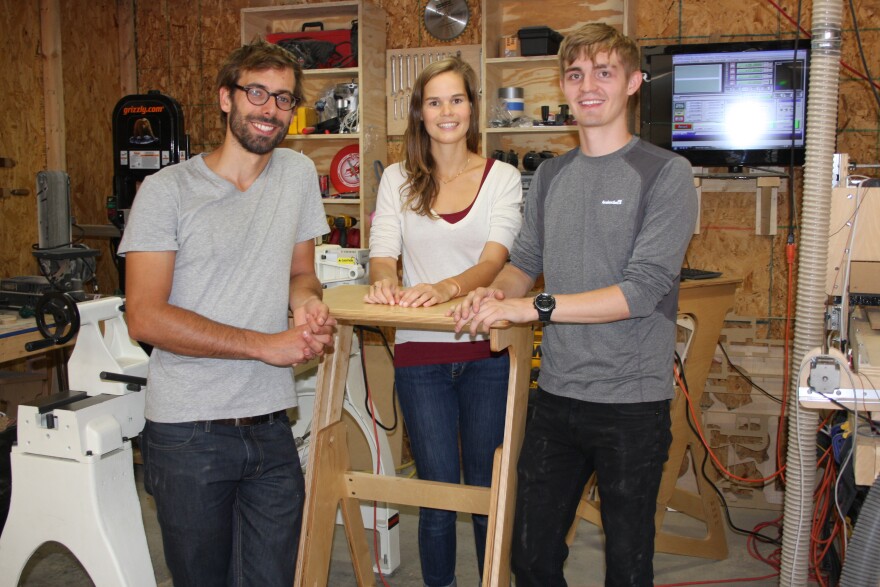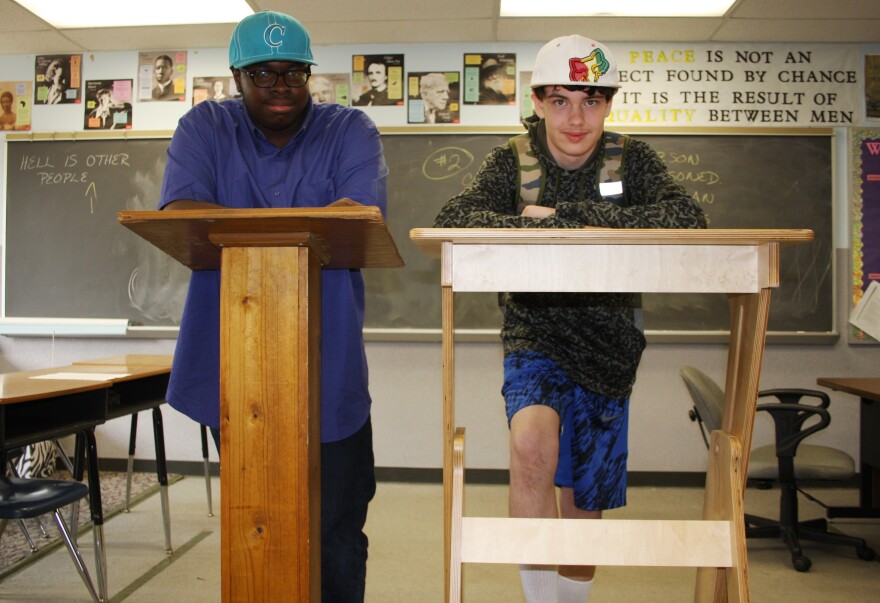Recent studies have shown that sitting too much is hard on your body. One way to combat the hazards of a sedentary lifestyle is to work standing up.
In this Week’s Exploradio, WKSU’s Jeff St.Clair looks at an Akron start-up that helps to get kids learning on their feet.
JASWIG is born
University of Akron grad student Daphne Fecheyr-Lippens discovered that doing research on the computer was a pain in the neck.
Fecheyr-Lippens says sitting for hours led her to develop "serious neck and shoulder pains," and ensuing migraines.
The solution, she realized, was to work standing up.
But buying a stand-up desk was out of the question for the cash-strapped college student, so she and her Belgium boyfriend, Mathias Ellegiers, a recently graduated structural engineer, said, "Let’s build one; it’ll be way cheaper.”

They brought in fellow Akron grad student and wood worker Tyler Schimmoeller for an all-night brain storming session.
"That same night," says Fecheyr-Lippens, "we came up with a really good solution of how we can adjust the height and still have a fully wooden desk.”
In November of 2014, JASWIG was born. It an anagram of the jigsaw-puzzle-like assembly process they developed.
Building a better desk
Schimmoeller then set about building a machine to build the adjustable stand-up desk.
“I learned all this on YouTube," he says, demonstrating his custom-made, computer controlled, or CNC, router in the team's garage workshop.
Schimmoeller shows me how the JASWIG height adjustment works.

"Anyone can walk up and do it,” he says. "Lift and pull it towards you; you either raise or lower the desk."
The adjustable legs fit easily into hidden notches for optimal height.
The goal of JASWIG is not only to sell stand-up desks to fellow college students and professionals; they want to get their desks into schools.
They say fidgety kids need the option to stand-up in class, and they’re starting with a very special school in Akron.
Allowing kids to learn on their feet
The Steel Academy on Akron’s east side caters to kids with attention deficit disorders and autism.
Steel-drum music is central to the school's teaching philosophy. Founder Angel Lawrie demonstrates the little step kids use while playing.

“This is called chippin’," she says, "It’s something that comes from the island, but it’s also forcing left-brain, right-brain activity to happen.”
Lawrie says playing the drums engages the brain and body, "and the standing desk, what I’m excited about that is that’s continuing that into the academics.”
In the classroom, ninth-grader Ananda Owens, who has ADHD, is trying out the JASWIG standing desk.
“I need to move around,” says Owens.
At the stand-up desk, she says, “You can do your work with this and it's better."
As with most schools, she says, "We sit a lot all day.”
The hazards of sitting
JASWIG’s Ellegiers is outfitting Owen's English class with 25 stand-up desks specially adapted for fidgety kids. He’s added a tactile carpet pad, a squeezy ball, and slots to keep mobile phones in view.
It’s part of a research project to measure any changes in the kids’ attitudes toward learning while standing compared to sitting.
Surveys over a six-week period will assess, "the atmosphere in the classroom," says Ellegier. "Is the class more task-focused; is the class proceeding faster, or better, and are children believing in their own capabilities? Those are the things we are testing out.”
Beyond ADHD
A growing body of research shows the hazards of sitting too long, not just for kids with ADHD.
Dr. Michael Roizen is chief wellness officer at the Cleveland Clinic.
“We know that if you sit for more than two hours your body gets physiologically older,” says Roizen.
Dr. James Levine of the Mayo Clinic calls today's "sitting disease" a lethal habit.
Stand-up desks are nothing new.
Rubber company founder B.F. Goodrich worked at a standing desk in the 1880’s. His desk is part of the collection at the Summit County Historical Society.
“He actually tested tires on this desk, which is part of the reason it’s so banged up,” says curator Ted Mallison.
He says a sedentary lifestyle is a relatively modern invention. "It wasn’t that common to sit around until the 20th century.”

The best position is the next position
Back at their garage workshop, the JASWIG entrepreneurs are busy putting the finishing touches on one of their new desks.
Ellegiers says a stand-up desk in schools could help the next generation build posture habits that can last a lifetime.
“If we can make one that is affordable enough to give children the choice to stand-up, that actually might change a lot.”
Designer Tyler Schimmoeller says the real benefit of a stand-up desk is that it makes it easier to move more.
“It’s about flexibility.”
He says the best position is the next position.














